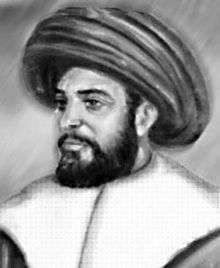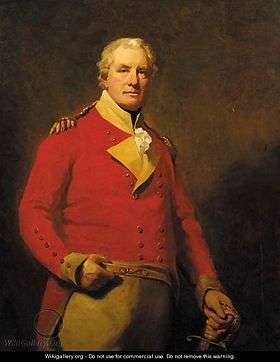Alexandria expedition of 1807
| Alexandria expedition of 1807 | |||||
|---|---|---|---|---|---|
| Part of Napoleonic Wars and campaigns of Muhammad Ali of Egypt | |||||
 Battle of Rosetta 1807 | |||||
| |||||
| Belligerents | |||||
|
|
| ||||
| Commanders and leaders | |||||
| General Alexander Mackenzie-Fraser |
Muhammad Ali Umar Makram | ||||
| Strength | |||||
| 6,000 regulars | Unknown | ||||
| Casualties and losses | |||||
| 900 + | Unknown | ||||
The Alexandria expedition of 1807 or Fraser expedition (Arabic:حملة فريزر) was an operation by the Royal Navy and the British Army during the Anglo-Turkish War (1807–1809) of the Napoleonic Wars to capture Alexandria in Egypt with the purpose of securing a base of operations against the Ottoman Empire in the Mediterranean Sea. It was a part of a larger strategy against the Ottoman-French alliance of the Ottoman Sultan Selim III.[1] It resulted in the occupation of Alexandria from 18 March to 25 September 1807.[2] The people of Alexandria, being disaffected towards Muhammad Ali, opened the gates of the city to the British forces, allowing for one of the easiest conquests of a city by the British forces during the Napoleonic Wars. However, due to lack of supplies, and inconclusive operations against the Egyptian forces, the Expedition was forced to embark the transports again, and leave Alexandria, not having reached any specific goals towards influencing the Ottoman Empire's improving relations with France.
The Expedition commences
The Expedition began in mid-February 1807 when a force of British troops deployed in Calabria and Sicily was ordered by General Fox in Messina[3] to embark on transports with a mission rumoured to be destined for Constantinople while John Thomas Duckworth, appointed second in command of the Mediterranean Fleet, sailed for Constantinople, but he failed to provide effective support for Dmitry Senyavin's Imperial Russian Navy in the Dardanelles Operation. After departure from Constantinople, as an Admiral of the White Squadron[4] he was to rendezvous with the transports in Aboukir Bay. However, by 17 March the fleet of transports with nearly 6,000 British troops embarked on board approached off Alexandria under the command of General Alexander Mackenzie-Fraser.[5]
Occupation of Alexandria

The appearance of the British transports off Alexandria was unexpected, and two Ottoman frigates, Uri Bahar (40 guns) and Uri Nasard (34 guns) and the corvette Fara Numa (16 guns) were taken as prizes on 20 March by HMS Tigre.[6] HMS Apollo with nineteen other transports had separated from the main force on 7 March, and were not present during the initial landings.
The sole garrison of the city at this time consisted of Albanian troops, which the French Consul-General Bernandino Drovetti[7] attempted to force to repel the British landing west of the city.[6] Despite the high surf, almost 700 troops with five field guns, along with 56 seamen, commanded by Lieutenant James Boxer, were disembarked without opposition near the ravine that runs from Lake Mareotis to the sea.[8] These troops breached the palisaded entrenchments at eight in the evening on the 18 March. It was fortuitous that serious resistance was not offered because the lines stretching from Fort des Baines to Lake Mareotis included eight guns in three batteries, and thirteen guns in the fort on the right flank.[6] British casualties were light, however the Pompey Gate[9] was barricaded and defended by about 1,000 troops and armed volunteers, forcing British troops to set up camp to the south. Two detachments were sent to occupy Aboukir Castle, and the "Cut", Qaitbay Citadel, a castle in Alexandria between lakes Maadia and Mareotis, to prevent Ottoman reinforcements reaching the city. On the next day 20 March the rest of the transports appeared off Alexandria, and an Arab messenger was sent with an offer of capitulation that was accepted by the city authorities. Sir John Thomas Duckworth also appeared on the 22 March[6] off Alexandria in his flagship HMS Royal George[10] with a part of his squadron,[8] further bolstering the confidence of the British troops.
On the occupation of the city, Fraser and his staff first heard of the death of Muhammad Bey al-Alfi, upon whose co-operation they had founded their hopes of further success; and messengers were immediately despatched to his successor and other local Beys, inviting them to Alexandria. The British Resident, Major Missett, with support from Duckworth, was able to convince General Mackenzie-Fraser of the importance of occupying Rosetta (Reshee'd) and Rahmanieh (Er-Rahhma'nee'yeh) to secure supplies for Alexandria because they controlled the canal, by which supplies were brought to the city via the Nile.[11]
Attempts to supply the expedition

1500 troops of the 31st Foot and the Chasseurs Britanniques were detached, accompanied by a section of Royal Artillery, under Major-General Patrick Wauchope[12] and Brigadier-General the Honorable Robert Meade,[13] on a mission to secure the Abourmandur Heights[14] outside the city.[15] They force entered Rosetta without encountering any opposition, but as soon as they had dispersed among the narrow streets, the garrison opened fire on them from the latticed windows and the roofs of the houses. They retreated on Aboukir and Alexandria, after a very heavy loss of General Wauchope, three other officers and 185 men killed, and General Meade, nineteen other officers and 281 men wounded.[16] The heads of the slain were fixed on stakes on the sides of the road crossing the Ezbekia in Cairo.[17][18]
Manoeuvring against Muhammad Ali
Muhammad Ali, meanwhile, was conducting an expedition against the Beys in Upper Egypt (he later defeated them near Assiut) when he heard of the arrival of the British. In great alarm lest the beys should join them, especially as they were far north of his position, he immediately sent messengers to his rivals. Ali promised to comply with all the Beys demands if they should join in expelling the invaders; this proposal being agreed to, both armies marched towards Cairo on opposite sides of the river.
Occupation of Rosetta

The possession of Rosetta being deemed indispensable, Brigadier-General Sir William Stewart and Colonel Oswald were despatched there with 2500 men. However, a deputy of Muhammad Ali of Egypt, Umar Makram, had begun to rally the local population and bring troops from Cairo in the attempt to slow the British advance towards the capital. They fought a running battle for fifteen days against superior Turkish forces, including a thirteen-day cannonade of the town without effect.[17] On April 20, news arrived from the advanced guard at Al Hamed of the arrival of 50-60 large vessels with reinforcements to join the besieged by Nile,[16] and General Stewart was compelled to retreat.[19] A dragoon was despatched to Lieutenant-Colonel Macleod, commanding at Al Hamed, ordering him to fall back as well,[17] but the messenger was unable to reach the British position. On 21 April, the advanced guard, numbering 733 and comprising a detachment of the 31st, two companies of the 78th, one of the 35th, and De Roll's Regiment, with a picquet of dragoons, was surrounded.[17] the survivors, who had expended all their ammunition, became prisoners of war.[20] General Stewart regained Alexandria with the remainder of his force, having lost over 900 men, killed, wounded and missing.[16] Hundreds of British heads were exposed on stakes in Cairo, and the prisoners were marched between these mutilated remains.[17] However, this time the British prisoners were well treated, and officers were given quarters in the Citadel.[20]
Siege of Alexandria
The defeat at Rosetta forced Mackenzie-Fraser to reconsider his position, and British troops were ordered to reoccupy Alexandria which was soon besieged by the Arab and Mamluk troops from Cairo.[19] Using his feigned good will as a pretext, Muhammad Ali then offered the British the freedom to receive supplies from Duckworth's transports as well as a grain trade agreement with an added assurances of security for any trade routes to India in return for recognition of his independence from the Ottoman Empire. The grain agreement was accepted, and supplies continued to be delivered to the British troops in Alexandria. However, formal recognition of independence was not given by the British Government, which had no intention of seeing the Ottoman Empire dismantled at this time.[19]
Departure from Alexandria
Colonel Dravetti, now advising Muhammad Ali in Cairo, was able to persuade the dictator to release the British prisoners as a good will gesture, sparing them the usual fate of becoming slaves to their captors.[18] In September, when no further use could be gained from occupation of Alexandria, General Mackenzie-Fraser was permitted to surrender the city[1] and withdraw to Sicily on the 25th.[16]
Expedition Order of Battle
|
The Royal Navy |
The British Army |
See also
Citations and notes
- 1 2 p.25, Olson, Shadle
- ↑ Olson, James Stuart; Shadle, Robert. Historical Dictionary of the British Empire, Volume 1. p. 25.
- ↑ p.684, Yeo
- ↑ pp.108-122, Lysons
- ↑ p.141, Scott
- 1 2 3 4 p.609, The Literary Panorama
- ↑ A Piedmontese Colonel who had served in the Egyptian Campaign with Napoleon, p.76, Manley, Ree
- 1 2 p.313, James
- ↑ also known as the Pompey's Pillar
- ↑ George Thom
- ↑ p.308, Bell, Balbis
- ↑ of Edmonston
- ↑ David Stewart (1825). Sketches of the Character, Manners, and Present State of the Highlanders of Scotland: With Details of the Military Service of the Highland Regiments. Constable. p. 345.
- ↑ heights of Caffarille and Cretin
- ↑ p.595, The Monthly Magazine
- 1 2 3 4 p.520, Russell, Jones
- 1 2 3 4 5 p.19,Lane, Thompson
- 1 2 p.76, Manley, Ree
- 1 2 3 p.26, Olson, Shadle
- 1 2 p.7, Hassan, Fernea
- ↑ commanding the naval part of an expedition Sir Benjamin Hallowell (1761 - 1834)
- ↑ p.287, Hart
References
- Alsager Pollock, Arthur William, (ed.), The United Service Magazine, Notes of an Expedition to Alexandria of the year 1807, H. Colburn [etc.], 1837
- Scott, Walter, The Life of Napoleon Buonaparte, Emperor of the French: With a Preliminary View of the French Revolution, vol.II, Carey, Lea & Carey, Philadelphia, 1827
- The Monthly Magazine; or British Register, Vol.XXIII, Part I for 1807, July 1, Richard Phillips, London
- The Literary Panorama, Vol.II, Letter from Major General [Mackenzie-]Fraser to Viscount Castlereagh, London, Charles Taylor, 1807
- Manley, Deborah & Ree, Peta, Henry Salt: Artist, Traveller, Diplomat, Egyptologist, Libri Publications Ltd., 2001
- Olson, James Stuart & Shadle, Robert, Historical Dictionary of the British Empire, Robert T. Harrison, Alexandria, British occupation of (1807), Greenwood Publishing Group, 1996
- Hart, H.G., Captain 49th Regiment, The New Annual Army Lists for 1848, Ninth annual volume, containing the dates of Commissions, and statement of the war services and wounds of nearly every officer in the Army, Ordnance and Marines, John Murray, London, 1848 (includes Militia List, and Imperial Yeomanry List)
- Russell, William & Jones, William, The History of Modern Europe: With a View of the Progress of Society from the Rise of the Modern Kingdoms to the Peace of Paris, in 1763, Vol.III, Harper & brothers, New York, 1839
- Bell, James, A System of Geography, Popular and Scientific: Or A Physical, Political, and Statistical Account of the World and Its Various Divisions, Vol.III, Archibald Fullarton and Co., Glasgow, 1832
- Hassan, Hassan & Fernea, Robert, In the House of Muhammad Ali: A Family Album, 1805-1952, American University in Cairo Press, 2000
- Lane, Edward William & Thompson, Jason, Description of Egypt: Notes and Views in Egypt and Nubia, Made During the Years 1825, -26, -27, and -28 ..., American University in Cairo Press, 2000
- James, William, Naval history of Great Britain, Vol. IV,
- Yeo, Richard R., The Edinburgh Encyclopaedia, Routledge, 1999